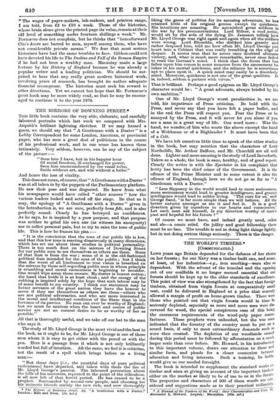LONG years ago Britain depended for the defence of her
shores on her forests ; for our Navy was a timber-bunt one, and some, at least, of her industries—e.g., iron smelting—were also to dependent. With the advent of the ironclad and the opening out of our coalfields it no longer seemed essential that our forests should be kept up to the older standards of excellence. This point of view was also strengthened by the fact that fore* timbers, obtained from virgin forests at comparatively small oast, could be delivered in England at a price that scarcely allowed a margin of profit on home-grown timber. There were those who pointed out that virgin forests would in time ho seriously depleted, especially as more and more uses were ells' covered for wood, the special conspicuous case of this being the enormous requirements of the wood-pulp paper manu- facturer. These prophets were unheeded, but the war NOD indicated that the forestry of the country must be put on a sound basis, if only to meet extraordinary demands such as were then created. The depletion of our woodlands caused during this period must be followed by afforestation on a 131116 larger scale than ever before. Hr. Howard, in his introduction to this important volume, draws our attention to these and similar facts, and pleads for a closer connexion between education and living interests. Such a training, he hold' would give us our needed foresight. The book is intended to supplement the standard works nu timber and aims at giving an account of the important timber' either on the market or likely to be of use to us in the future. The properties and characters of 500 of these woods are aidered and suggestions made as to their practical utilization'
• A Manual of the Timbers of the World: their Characteristics and Os.
Alexander L. Howard. London: Itaemillaa (305. net.]
Quito a large .amount of information is given on the cultural conditions neceaswy for many of the best timber trees and on the passibility of growing them in this country.
This special part of the work is followed by a more general one, dealing with the conversion and preservation of timber, specifications and conditions of contract; then comes a very important section dealing with the artificial seasoning of timber. In his remarks on specification our author points out the need for cloaer co-operation between builder and timber merchant with the view of ensuring a solution of the problems presented on both sides, and suggests that, in this country, it would be beneficial to have a set of standard grades of wood on lines similar to those laid down by the National Hardwood Lumber Association in America. The treatment of such matters as the proper time for felling timber, &c., is much too slight, and either more consideration should have been given them or the reader should have been referred to some such work as Record's Mechanical Properties4 Wood.
The article on the seasoning of timber is the contribution of Mr. S. Fitzgerald, who has had considerable practical experi- ence of this part of the subject in Finland. It is pointed out here that under properly and scientifically controlled artificial drying ice have a surer means of treating timber than is at our disposal when we allow Nature to do the work, uncertain as she is in action. A large quantity of wood which has been placed on the market as artificially seasoned has not been treated with the necessary care, and this has undoubtedly caused prejudice against the artificially dried article. Mr. Fitzgerald will go far towards dispelling this prejudice.
The book is fully illustrated and well arranged ; it will be of more use than its author modestly imagines.







































 Previous page
Previous page